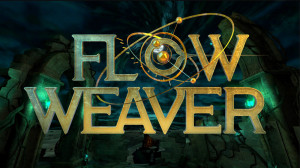Review for Flow Weaver

Escape room-style PC games are not new, but they have been trending and gaining in popularity in recent years, and are now finding their way to VR. Flow Weaver is one of the first such games released on virtual reality platforms so far, but while it offers some fun challenges and a well-constructed plot, its limited controls are consistently cumbersome and several leaps of logic are needed to solve some of the puzzles, only to escape one prison to find yourself trapped in another, which results in a disappointing ending.
You play as an eponymous Flow Weaver, a mage capable of traveling between worlds (“flows” as the game describes them), each of which is a varied reflection of the others and interconnected with the realm of mortals. As a student learning to channel the magic of these dimensions into spells (important in solving puzzles), you are practicing for your final exam. You pick a destination using your Planar Compass, but something goes horribly wrong and you find yourself trapped in a cell, along with a skeleton that ominously portends your fate if you can’t escape.
The basic gameplay mechanics are explained early on with brief prompts. If you try to physically move anywhere in your VR play area, you are scolded with a reminder that the game must be played in the sitting position – the result of a ring of binding at your feet, a plot device to explain this limitation. That doesn’t mean you’re confined to the current room, however, as accessing the Planar Compass – the in-game interface for teleporting to various worlds and accessing different spells – is a simple button press away. Once opened, to enter an available realm you must hold the grab button on either hand controller and drag the desired realm down to open a rift in time/space that takes you there.
There is no inventory system, but it is possible to acquire and hold certain items to use in solving puzzles. To interact with objects at any destination, you combine the grip and trigger buttons. (Eventually you will learn to detect magic by “meditating,” which reveals all the hotspots in your location.) Although this mechanic is straightforward in theory, I had a lot of difficulty with it – a large part of the gameplay – and really never did master it on my Oculus Rift S. In particular I found it very difficult to actually grasp anything, as my hand just kept passing through the object I sought. I often had to try many times while holding down the appropriate controller button until I was successful.
While you are able to directly interact with some things, such as opening a chest and grabbing a skull inside, you usually need to employ a spell (the first of several) called “Shadowhand,” which allows you to move and place objects in your current location using the thumbstick of either controller. In some cases you can carry an item from one realm to another. I struggled with using this spell too, because you must first drag it toward you from the Planar Compass to activate it, select the object you want to interact with using the trigger button, and then use the grab button and thumbstick simultaneously to move the object where it is needed.
A really cool feature in Flow Weaver is the ability to use something in one realm that impacts a different object in another. For example, if you hang a lantern of a certain colour on a hook in your cell and then transport to a cloud-like realm, there is a laser beam of that same colour on a similar hook. If you return to your original realm and change the lantern to a different colour, that new laser colour back in the cloud world will be altered as well. While I have played a few other games employing a similar feature, it is implemented particularly well here.
You learn via a series of glowing orbs that appear above your head as you progress. In this way you’ll discover that you have been cut off from your normal flows, and in order to escape you will need to find portal keys that open new dimensions in your Planar Compass. Once you have solved the necessary puzzles in each location, you’ll find the key to the next, after which point you can move freely between them. There are a total of five realms, the first of which is the Material World, specifically the cell you find yourself in at the beginning. From here you will visit the Shadowrealm, a land of the dead; Feylands, a wooded area filled with empty bottles and alcoholic faeries; the Underworld, which not surprisingly looks like Hell; and finally Skybridge, which is a cloud city with advanced technology. Unfortunately, in order to travel to each location you must first pass through the Material World, which seems a bit redundant.
Despite their inherent connectedness, each setting looks very different from the others with their respective graphical details and distinctive colour palettes (dark and grey in Shadowrealm, deep reds in the Underworld, and so on). Each contains puzzles organic to that location, such as the need to deploy the fire spell in the Underworld, or taking advantage of the fertile soil in Feylands. But because you are forced to remain seated at all times, you are not able to fully explore any of these areas. I was disappointed in this inability to take full advantage of the VR platform, since each realm is visually intriguing and cries out to be poked and prodded more fully.
The story is revealed mainly via the protagonist’s many (and often lengthy) monologues, along with interactions with various characters. The antagonist is known as the Necromancer, who captured you and is holding you prisoner. You learn a bit about her from the Spirit, a fellow Flow Weaver you meet in the Shadowrealm who was killed by a dragon. As you explore the different realms, you begin to question the motives of the Necromancer. Are you being tested and, if so, for what purpose? It turns out the Necromancer, unlike you, is not able to access certain realms and so needs to master this skill to prepare for a great conflict that is coming soon. You need to warn your teachers, but you must escape first. You eventually will – but saying that isn’t a spoiler because sadly that is not the end of your problems. Instead you ultimately end up in a brand new place with a “to be continued” ending, which was very disappointing.
Since much of the story is based on the extensive monologues of the main character, I was surprised by the poor quality of the voice acting by Ciarán Strange (perhaps best known for his work in Borderlands 3). The lines are delivered in an uneven manner throughout, sometimes in a bland monotone and others with exaggerated inflections. You can turn off voices and enable subtitles, but a bug I encountered displayed the text in a tiny font at the very bottom of the screen, which I had a lot of trouble reading. Worse, you cannot skip any of the dialog or get on with puzzle solving while it plays out. When you restore from an autosave point, sometimes you need to sit through a lot of speeches you have heard before. At least the voice-overs for the other characters are average to good, with the dragon in particular giving a strong performance.
Thankfully the audio quality is much better in other respects. Background music is minimal, with just a few piano notes here and a bit of guitar there, but there are neat effects when you “tear” open a new flow or access a spell. Each realm has its own signature ambience, such as birds chirping in Feylands, a furnace roaring in the Underworld, and wind whirling in Skybridge. These subtle yet persistent sounds really add to the feeling of being there. The graphics are adequate but not as detailed or crisp as I would have expected, given that all the locations are fairly static and offer no ability to view them in three dimensions.
The creative puzzles are the true star of this game, as using an object in one flow to solve a problem in another adds a new and refreshing element to the standard formula. With the exception of needing to discover several four-digit codes to unlock a safe in the Material World, all challenges require manipulating items in the various realms and using the spells you find along the way. In addition to the Shadowhand spell to manipulate objects, you will acquire Commune, which lets you talk to different characters you meet; Fire Power to burn or heat things; and Control Weather to create rain and other climatic effects.
In most instances you are pretty much told what needs to be done by the main character or someone else once you get to the correct trigger point. For example, at various points you are told you need to prop open a chest or dispose of some old rope twisted up in a mechanism’s gears. You even get a clue from the “Continue” button about what you need to do each time you return to the game. Although these clues may sound excessive, you still need to do a fair bit of thinking and experimenting to solve the actual puzzles, which is usually quite rewarding.
Several puzzles can be quite frustrating, however, especially finding the different combinations to the safe in the Material World. Here you really need to pay attention, as there are almost no clues. The first combination is easy, but they get much more difficult as you advance. Everywhere you go, you need to be on the lookout for subtle patterns, which are easy to miss. The sole exception is in plain sight, though even that won’t mean anything until you know exactly what you’re looking for.
A few other puzzles were just too obtuse for me to solve without outside help. One in Skybridge in particular is a multilevel sequence that requires some leaps of logic. Not only do you need to make an unintuitive connection between rooms, you must figure out the correct order of coloured lamps to place in one world to effect the change desired in another. You’ll also need to manipulate an astrolabe to activate the crucial part of the puzzle, and then later work out how to energize the last portal key needed to end the game. This involves a fair bit of trial and error, as there is no indication that you're getting close to the correct alignments. In addition, you need to obtain a runestone (one of several needed to unlock the key of binding at your feet), but there are no clues to how to do that (at least that I could find), or even a hint that one is available.
While I did somewhat enjoy playing Flow Weaver for the 7–8 hours it took to complete, and I appreciated the interesting storyline and interdimensional puzzle solving overall, there are too many hurdles to overcome to fully recommend it. Beyond the mechanical problems I experienced, a combination of uneven voice acting, limited exploration, humdrum graphics, some poorly clued puzzles, and the non-existent ending ultimately mean there are more rewarding VR adventure games available. The next chapter looks ominous and even darker, so hopefully the lessons learned here can be put to good use and we’ll finally get some resolution to our magical imprisonment.































